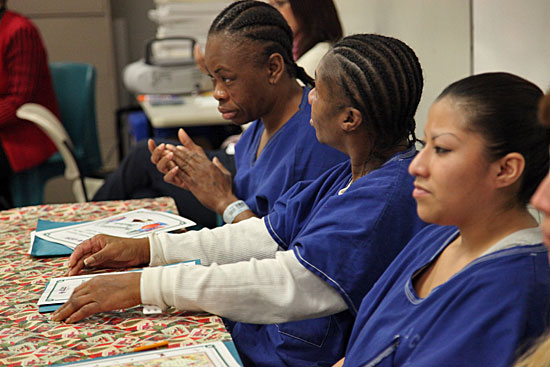
Female inmates in the county’s jail system can take part in a new and potentially transformative program.
Inside Dorm 3500 of the county’s Century Regional Detention Facility in Lynwood, an experiment in personal reinvention is about to unfold.
The dorm’s 124 residents—all of them female inmates of the Los Angeles County jail system—will be embarking on a new program dedicated to the proposition that women and men take very different paths to jail and need very different kinds of help to address the underlying causes that landed them there.
“Women come into the incarcerated life differently than men do. The majority of women have some kind of abuse in their background—physical or sexual. I hate to use the term ‘victim,’ but in many cases they are,” said Sgt. Christina Baker of the sheriff’s inmate programs unit. Those physical, sexual and emotional traumas often lead women to substance abuse, which in turn brings a host of criminal and other behavioral problems.
The Sheriff’s Department’s new “gender-responsive” program aims to give women—often for the first time in their lives—a chance to recognize and change those destructive patterns. “It’s basically a chance to reinvent themselves,” Baker said.
Although women inmates make up just 10% or so of the county’s jail population of around 20,000, they tend to be avid consumers of self-help and other programs, Baker said. Women “want that education, that life-changing element,” she said, noting that male inmates, by contrast, are often “wrapped up in jail politics” and afraid that taking part in programs will mark them as weak.
Karen Dalton, director of the sheriff’s Inmate Services Bureau, said she participated in a trial session of the program and found the hands-on, small group activities eye-opening, such as a session that used photos in magazines to connect with women’s feelings about themselves. “It’s a very interactive way of getting people to think differently about themselves, and not use the trauma as a crutch,” she said. “We’ve wanted this for a very, very long time.”
The women’s program, the first of its kind in the Los Angeles County jail system, will include one-on-one assessments, life skills training, domestic violence education, substance abuse recovery, behavioral therapy and other elements—all aimed at having an impact that goes well beyond individual inmates.
“It’s not just about the women,” said Renee Smith, who directs women’s services for Haight Ashbury Free Clinics-Walden House. “Women have babies, and families. It’s also about stopping the cycles for generations.”
Smith’s organization this week was awarded a contract to run the program for three years, with an option to continue for an additional 2½ years, at a total cost of up to $3.5 million.
Smith said similar programs have been run in the California prison system, and on a smaller basis in the San Francisco jail. The L.A. County program, to be offered first to female inmates who already have completed all available courses in the jail educational curriculum, is notable for the “constellation” of services it will offer.
“This is really a full program. This is what you’d get if you walked into residential treatment in the community,” Smith said. She said the women will be learning everything from “mindfulness” skills to how to write a letter to an estranged family member to the basics of navigating bureaucratic systems—“when to keep your mouth shut and when to speak up when you have a need.”
Unlike state prisoners serving lengthy sentences, county jail inmates tend to come and go more quickly. The average jail stay currently is about 44 days, although that’s likely to increase as prisoners who previously would have been sent to state prison instead do their time in county jail under the process known as realignment. And, at least as far as rehabilitation programs are concerned, that may not be a bad thing.
“The longer they’re here, the more treatment they receive,” Sgt. Baker said.
Stephanie Covington, who co-directs the Center for Gender and Justice and is a nationally-recognized leader in the field, said the criminal justice system has not always been so open to the notion of giving women inmates treatment geared to their backgrounds and needs.
“In the last 10 years, there’s been a growing understanding of the need for women to have different kinds of services,” she said. “It makes no sense to warehouse people.”
And, she said, even relatively short-term programs can make a difference.
“It’s time you can plant seeds,” she said. “You can help people see there are other options.”
Posted 3/7/12






